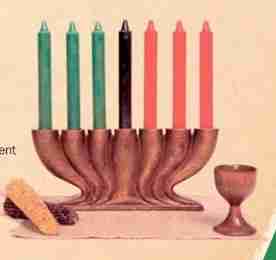Kwanzaa has seven basic symbols and two supplemental ones. Each represents values and concepts reflective of African culture and contributive to community building and reinforcement. The basic symbols in Swahili, and then in English, are:
Mishumaa Saba (The Seven Candles):
These are symbolic of the Nguzo Saba, the Seven Principles, the matrix and minimum set of values which African people are urged to live by in order to rescue and reconstruct their lives in their own image and according to their own needs.
Bendera (The Flag):
The colors of the Kwanzaa flag are the colors of the Organization Us, black, red and green; black for the people, red for their struggle, and green for the future and hope that comes from their struggle. It is based on the colors given by the Hon. Marcus Garvey as national colors for African people throughout the world.
Mazao (The Crops):
These are symbolic of African harvest celebrations and of the rewards of productive and collective labor.
Muhindi (The Corn):
This is symbolic of African-descended children and their future which they embody.
Mkeka (The Mat):
This is symbolic of African tradition and history and therefore, the foundation on which we build.
Kinara (The Candle Holder):
This is symbolic of African roots, the parent people – continental Africans.
Kikombe cha Umoja (The Unity Cup):
This is symbolic of the foundational principle and practice of unity which makes all else possible.
Zawadi (The Gifts):
These are symbolic of the labor and love of parents and the commitments made and kept by the children.












No Comment